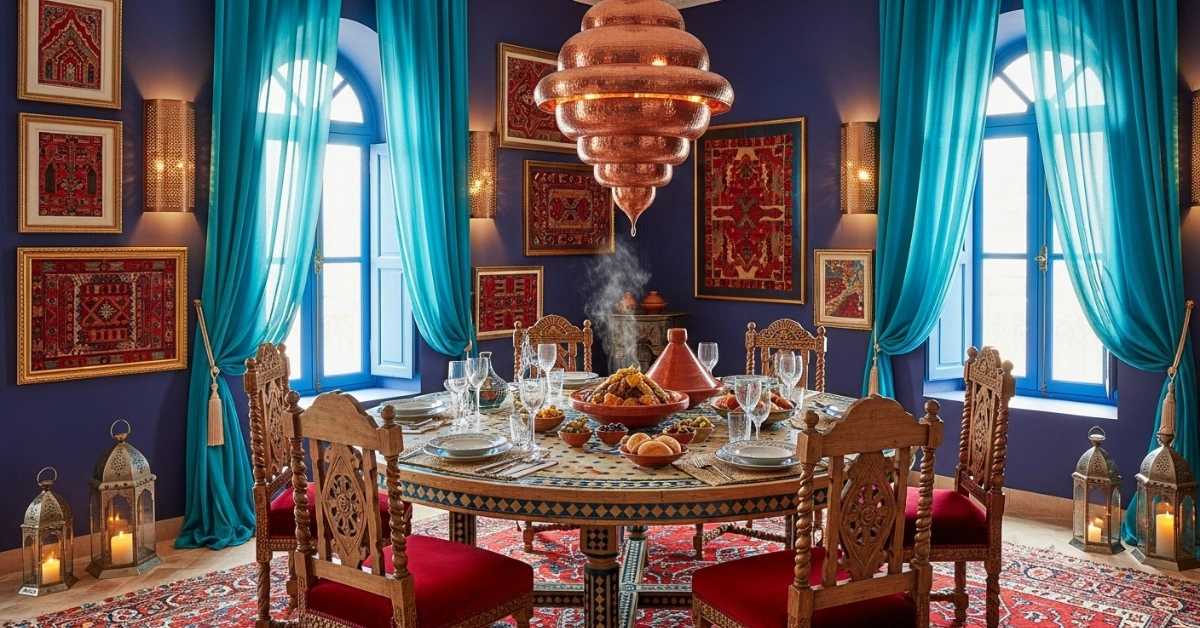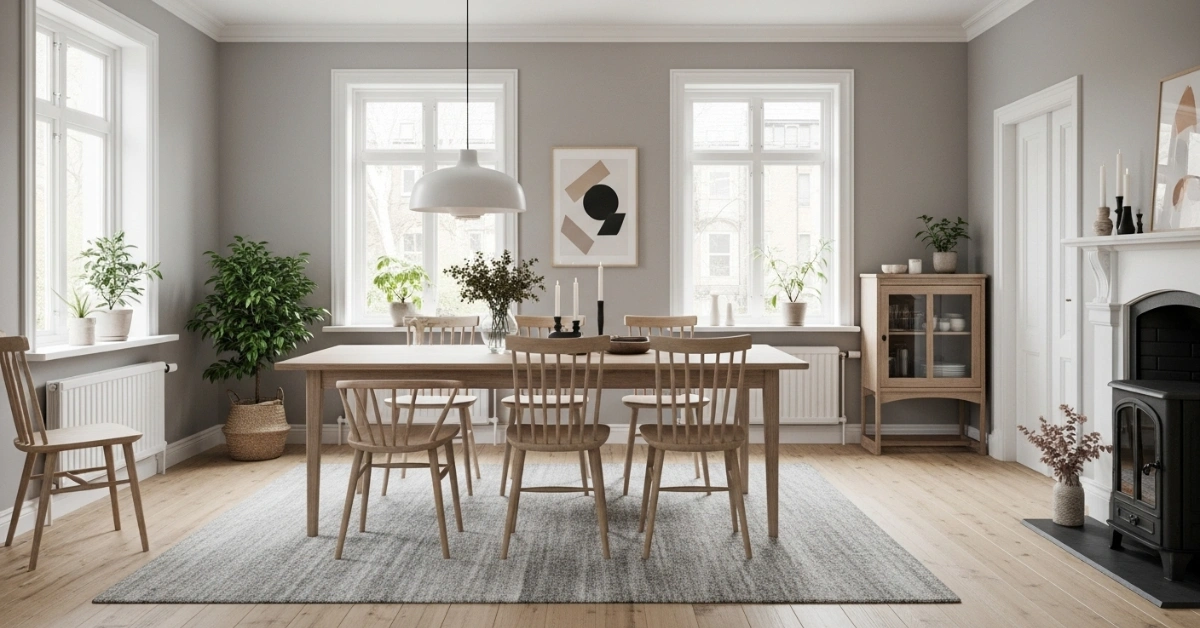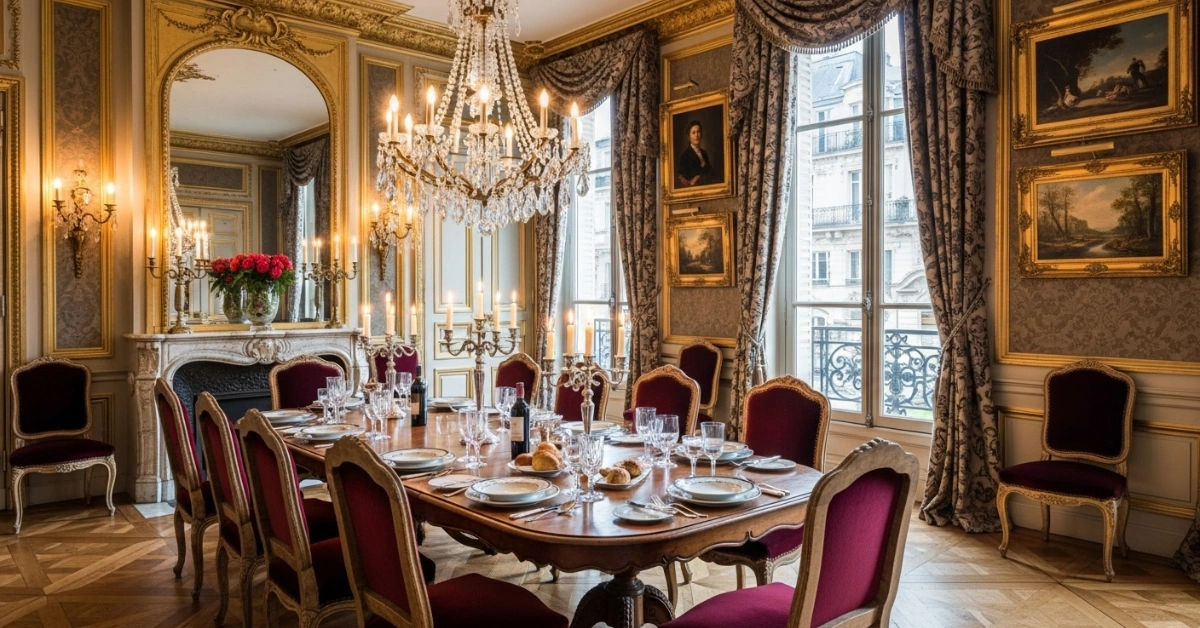11 Vibrant Moroccan Dining Room Design Ideas and Inspiration

Creating a dining space that feels inviting yet exotic can be a challenge. Many homeowners struggle to balance bold cultural elements with functionality, often ending up with rooms that feel either too plain or overly cluttered. A Moroccan dining room offers the perfect solution, blending vibrant colors, intricate patterns, and a warm, welcoming atmosphere that transforms every meal into a cultural experience. In this guide, we’ll explore practical tips, design inspiration, and expert insights to help you craft a Moroccan dining room that’s both stylish and timeless, ensuring your space stands out while remaining functional and cozy.
This article dives deep into the essence of Moroccan design, offering actionable ideas to bring this aesthetic to life. From choosing the right colors to selecting furniture and decor, we’ll cover everything you need to create a dining room that feels like a journey to Marrakech.

What Makes a Moroccan Dining Room Unique?
Moroccan design is rooted in a rich cultural history, blending influences from Berber, Arab, and Andalusian traditions. According to The Metropolitan Museum of Art, Moroccan art and architecture emphasize intricate tilework, bold textiles, and a harmonious mix of textures. In a dining room, this translates to a space that’s vibrant yet balanced, with layers of patterns and materials that create a sense of warmth.

Key Elements of Moroccan Style
- Bold Colors: Think jewel tones like sapphire blue, emerald green, and ruby red, paired with earthy hues like terracotta and sand.
- Intricate Patterns: Geometric shapes, arabesques, and zellige tile designs are hallmarks of Moroccan aesthetics.
- Textured Materials: Woven rugs, carved wood, and hammered metal add depth and authenticity.
- Low Seating: Traditional Moroccan dining often involves low tables and cushioned seating for a relaxed vibe.
- Lighting: Ornate lanterns and soft, ambient light create a magical atmosphere.
Interior designer Amina Kadir, who specializes in cultural aesthetics, shares, “A Moroccan dining room is about storytelling through design. Every piece, from the rug to the chandelier, should feel like it has a history.” This approach ensures your dining room feels personal and inviting.
Choosing the Perfect Color Palette for Your Moroccan Dining Room
Color is the foundation of any Moroccan dining room. The goal is to create a vibrant yet cohesive palette that feels warm and inviting. Start with a base of neutral tones like cream, beige, or soft gray to ground the space, then layer in bold jewel tones for impact.
Popular Moroccan Color Combinations
- Terracotta and Turquoise: A warm, earthy base with pops of cool blue for balance.
- Gold and Deep Purple: Luxurious and regal, perfect for an upscale dining experience.
- Saffron and Navy: Bright and bold, this pairing adds energy without overwhelming the space.

For example, in a recent project, I helped a client transform their bland dining area by painting the walls a soft terracotta and adding turquoise curtains. The result was a space that felt both grounded and vibrant, perfect for hosting lively dinner parties.
Tip: Use bold colors in moderation on accent walls, cushions, or tableware to avoid overwhelming the room. A good rule of thumb is to keep 60% of the room neutral, 30% in a primary color, and 10% in a bold accent shade.
Furniture Choices for an Authentic Moroccan Dining Room
Furniture in a Moroccan dining room should feel handcrafted and purposeful. Opt for pieces that blend functionality with artistry, such as carved wooden tables or upholstered chairs with intricate patterns.
Must-Have Furniture Pieces
- Low Dining Table: A round or rectangular table with carved details or inlaid tilework is a classic choice. Look for dark woods like walnut or mango wood for authenticity.
- Cushioned Seating: Floor cushions or low benches with vibrant upholstery create a relaxed, communal vibe.
- Statement Chairs: If you prefer standard-height dining, choose chairs with ornate carvings or upholstered in Moroccan-inspired fabrics.
- Sideboards or Consoles: A carved wooden sideboard adds storage and serves as a display for decorative items like ceramics or lanterns.

Pro Tip: Mix and match seating styles for an eclectic look. For instance, pair a low table with a combination of floor cushions and upholstered chairs to accommodate different preferences.
Designer Fatima Zahra notes, “The beauty of Moroccan furniture lies in its imperfections. Handcrafted pieces with slight variations tell a story of craftsmanship.” When shopping, prioritize pieces that feel artisanal over mass-produced items.
Textiles and Patterns: The Heart of Moroccan Design
Textiles are the soul of a Moroccan dining room, adding warmth and personality. From rugs to curtains to table runners, every fabric should contribute to the layered, inviting aesthetic.
How to Incorporate Textiles
- Rugs: A handwoven Berber rug with geometric patterns can anchor the space. Look for natural materials like wool or cotton.
- Cushions and Throws: Use bold, patterned cushions on chairs or benches. Mix stripes, florals, and geometric designs for a dynamic look.
- Table Linens: Opt for table runners or napkins in rich colors like saffron, indigo, or crimson, ideally with subtle embroidery.
- Curtains: Sheer curtains in neutral tones allow light to filter through, while heavier drapes in bold hues add drama.

For instance, a friend recently added a vibrant kilim rug to her dining room, paired with neutral linen curtains. The combination made the space feel cozy yet sophisticated, perfect for both casual meals and formal gatherings.
Tip: Don’t shy away from mixing patterns, but keep a consistent color palette to avoid chaos. A good mix might include one large-scale pattern (like a rug), one medium-scale pattern (like cushions), and one small-scale pattern (like napkins).
Lighting: Creating Ambiance in a Moroccan Dining Room
Lighting is crucial for setting the mood in a Moroccan dining room. Traditional Moroccan lanterns, often made of brass or iron with colored glass, cast intricate patterns of light that elevate the space.
Types of Moroccan Lighting
- Pendant Lanterns: Hang a cluster of lanterns above the dining table for a dramatic focal point.
- Wall Sconces: Install sconces with filigree designs to add soft, ambient light.
- Candles: Use decorative candle holders for intimate dinners, ideally in metallic finishes like gold or silver.
- Chandeliers: A wrought-iron or brass chandelier with intricate detailing adds elegance.

In one project, I installed a large brass lantern above a client’s dining table, paired with smaller candles on the table. The effect was magical, with soft light reflecting off the walls, creating a warm, inviting glow.
Tip: Use dimmable lights to adjust the ambiance for different occasions, from casual brunches to elegant dinner parties.
Decor and Accessories for a Moroccan Dining Room
Accessories are where you can truly personalize your Moroccan dining room. The key is to choose pieces that feel authentic and purposeful, avoiding clutter.
Essential Decor Items
- Ceramics: Hand-painted plates, bowls, or tagines in vibrant colors make stunning tableware or display pieces.
- Metalwork: Brass or silver trays, bowls, or teapots add a touch of luxury.
- Wall Art: Consider framed Moroccan tiles, woven tapestries, or mirrors with carved frames.
- Plants: Potted palms or succulents in decorative pots bring a touch of nature to the space.

Example: A client displayed a collection of hand-painted tagines on a sideboard, which became a conversation starter during dinners. The key was choosing pieces in complementary colors to tie the room together.
Tip: Use odd numbers when arranging decor (e.g., three lanterns or five plates) for a balanced, visually appealing look.
Flooring and Wall Treatments for a Moroccan Vibe
The right flooring and wall treatments can elevate your Moroccan dining room from ordinary to extraordinary. These elements set the stage for the rest of the design.
Flooring Options
- Zellige Tiles: Handmade Moroccan tiles with subtle imperfections are ideal for a statement floor. Common colors include white, blue, and green.
- Terracotta Tiles: Warm and earthy, these tiles provide a neutral base that pairs well with bold textiles.
- Wooden Floors: Dark hardwood with a distressed finish adds warmth and complements rugs.

Wall Treatments
- Tadelakt Plaster: This traditional Moroccan plaster technique creates a smooth, slightly glossy finish in earthy tones.
- Accent Walls: Paint one wall in a bold color like cobalt blue or use patterned wallpaper with geometric designs.
- Tile Accents: Add a border of zellige tiles around a doorway or window for a subtle nod to Moroccan style.

Tip: If installing tiles feels daunting, consider peel-and-stick tile decals for a budget-friendly alternative that still captures the Moroccan aesthetic.
Practical Tips for Designing a Functional Moroccan Dining Room
While aesthetics are important, functionality is key to ensuring your dining room is practical for everyday use. Here are some tips to balance style and usability:
- Maximize Space: If your dining room is small, opt for a round table to save space and encourage conversation.
- Storage Solutions: Use a sideboard or shelves to store tableware, keeping the space clutter-free.
- Comfortable Seating: Ensure cushions or chairs are comfortable for long meals, especially if you’re hosting frequently.
- Easy Maintenance: Choose washable fabrics and durable materials to keep the space looking fresh.

For example, a family I worked with chose a low table with floor cushions but added a few standard chairs for elderly guests. This compromise made the space accessible without sacrificing style.
Common Mistakes to Avoid in a Moroccan Dining Room
Even with the best intentions, it’s easy to make mistakes when designing a Moroccan dining room. Here’s what to watch out for:
- Overloading Patterns: Too many bold patterns can make the space feel chaotic. Stick to a cohesive color palette.
- Ignoring Scale: Oversized furniture can overwhelm a small room, while tiny pieces can get lost in a large space.
- Poor Lighting: Harsh overhead lights can ruin the ambiance. Always include soft, layered lighting.
- Skipping Texture: A lack of texture can make the room feel flat. Incorporate rugs, cushions, and metalwork for depth.
Designer Omar El Idrissi advises, “Less is more when it comes to Moroccan design. Choose a few standout pieces and let them shine.” This approach keeps the space balanced and inviting.
Budget-Friendly Ways to Create a Moroccan Dining Room
You don’t need a big budget to achieve a Moroccan dining room. Here are some cost-effective ideas:
- DIY Decor: Paint plain ceramic plates with Moroccan-inspired patterns using non-toxic paint.
- Thrifted Finds: Look for carved wooden furniture or brass accessories at thrift stores or flea markets.
- Textile Swaps: Use affordable fabrics from local markets to create cushions or table runners.
- Repurpose Items: Turn an old tray into a decorative centerpiece by adding metallic paint.

For instance, a friend transformed her dining room by shopping at a local flea market for lanterns and rugs, spending less than $200 to achieve a high-end Moroccan look.
Inspiration from Real Moroccan Dining Rooms
To spark your creativity, here are three real-world-inspired Moroccan dining room ideas:
The Modern Moroccan: A sleek dining table paired with vibrant cushions and a single statement lantern. Neutral walls keep the focus on colorful textiles.

The Rustic Retreat: A distressed wooden table with floor cushions, surrounded by terracotta walls and a woven rug. Potted plants add a fresh touch.

The Luxe Oasis: A gold-accented table with upholstered chairs, paired with a dramatic chandelier and zellige tile accents on the floor.

Each style shows how versatile Moroccan design can be, adapting to modern, rustic, or luxurious preferences.
Conclusion: Bring Your Moroccan Dining Room to Life
A Moroccan dining room is more than just a place to eat, it’s a celebration of culture, color, and craftsmanship. By blending bold colors, intricate patterns, and thoughtful textures, you can create a space that feels both exotic and inviting. Whether you’re starting from scratch or refreshing an existing room, the tips and ideas in this guide will help you craft a dining space that inspires and delights.
Ready to transform your dining room? Start by choosing one element perhaps a vibrant rug or a statement lantern and build your design from there. Share your Moroccan dining room journey with us in the comments, or visit a local home decor store to find your first piece today!






